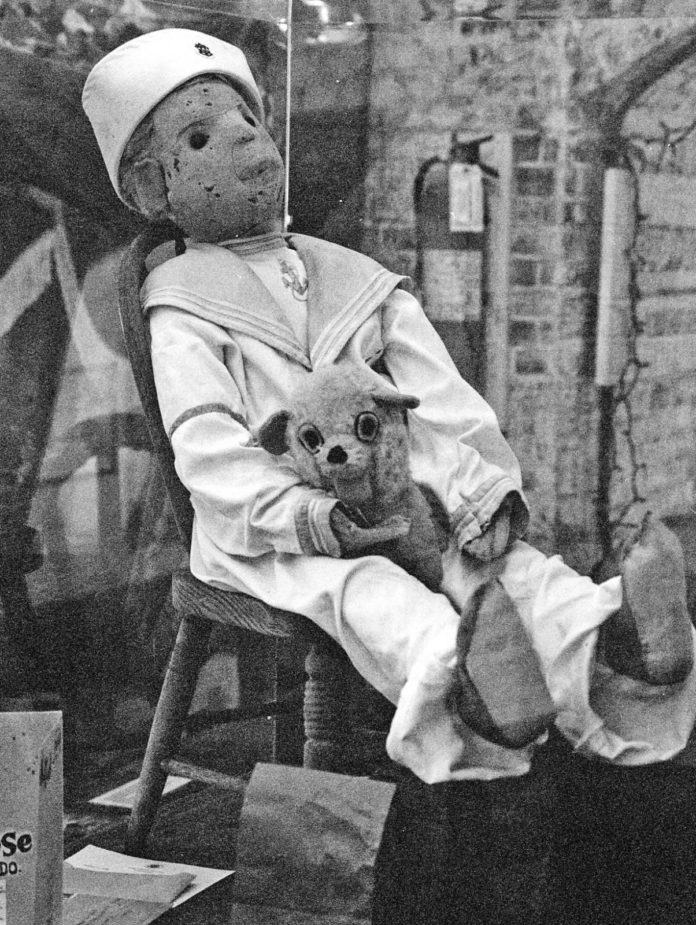Ghost stories are told up and down the island chain. In Key West, the haunted history is openly celebrated. It should be; it is considered one of the country’s most haunted cities. Also, there is not a local in the Keys who does not know the whereabouts of a skeleton or two.
In what might be the earliest recorded account of a Key West haunting, the Aug. 29, 1874, edition of the “Shenango Valley Argus” reported that “Key West has a ghost covered with hair and about the size of a horse” in its “Matters of Interest” column. A hairy ghost as big as a horse would be scary (and sounds a little bit like a Skunk Ape), but then Key West has always been a portal to the unusual and weird. Parking, too, is pretty scary on the island.
Like a cherry topping on a sundae of haunted layers, it is also home to Robert the Doll.
Robert is one of the scariest or most misunderstood haunted dolls in the world and one of the top haunted artifacts in the Florida Keys. Regarding Robert, contrary to some silly accounts of his history, he is in no way affiliated with or connected to the fictionalized dalliances of the murderous Chucky portrayed on the silver screen as a significantly more animated kind of doll.
Robert’s birthday, by the way, was Monday, Oct. 25. He turned 117.
Robert the Doll lives at Fort East Martello, a Civil War-era fortification that has been home to devastating tragedy. Perhaps not so surprisingly, it represents one of Key West’s most haunted locales. If you are brave or curious enough, David Sloan will take you on an after-hours tour of East Martello on his Ghost Fort Adventures. He will also introduce you to Robert the Doll. It is, after all, that spooky time of year.
The red-bricked walls built to protect the island from foreign attacks that never materialized instead housed some of the victims of a little, flying domestic terrorist known as the mosquito. The little vampire plunged its long, hollow tooth into human flesh in search of the blood it needed to survive. Sometimes it left behind a little “thank you” in the form of a viral disease called yellow fever. Yellow fever is recognized as malaria today.
Yellow fever outbreaks were the source of hundreds and hundreds of deaths in the Florida Keys. Some of the infected were brought to the fort. Those who died were stacked within the fort’s walls, which might account for its many hauntings.
Robert, Fort East Martello, and Key West are not the only haunts in the Florida Keys. Stories suggest Elliott Key is haunted, too. It would be a fitting bookend to the Key West hauntings if only in the sense that Elliott Key is considered the northernmost of the Florida Keys and Key West, continentally speaking, the Southernmost City.
With all the atrocities attributed to Elliott Key, how could the island not be haunted? Like Key West, Elliott Key has a history of death, and much of it is related to cruelty, if the stories of Black Caesar are to be believed. And there are a lot of stories about the pirate Black Caesar who reigned supreme over the Florida Reef from his Elliott Key lair on at least three separate occasions. A common thread connecting all of the pirate’s stories reveals his cruel nature.
In most accounts, he slays a friend after the two fight over a woman. Another Black Caesar hallmark was taking prisoners from the ships he conquered and bringing them back to the island. There, they were forced to dig holes on the Elliott Key beach where the pirate could bury his treasures. Upon completion of their work, the prisoners were killed and buried in the hole along with the booty.
Some of the deaths allegedly associated with the island were not as violent. They were cruel. According to the legends, another habit of the pirate was taking prisoners from his conquered prizes and holding them in stone cells he had constructed on the island. Some of those prisoners were women who gave birth to pirate babies. Most of the stories suggest that when the pirates left their lair in search of their quarry, they would forget to leave supplies or not leave adequate provisions of food and water for the prisoners and, in their absence, they would starve to death in their stone cells.
The children were said to have escaped and sustained their little feral colony on berries and what they could catch in the warm shallows washing against the island. According to the local lore, they communicated in their own primitive language. No one accounts for what might have become of them, though some say they haunt the island today. If ghosts exist, once the sun goes down over Elliott Key, it might not just be the wind rustling over the island making noise at night.




















